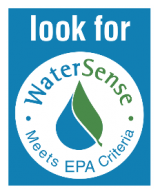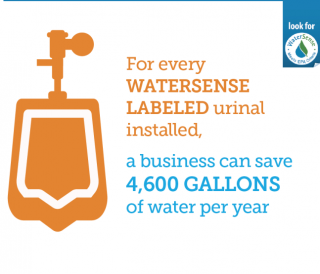Urinals


Urinals can account for a significant portion of indoor water usage in commercial and institutional settings. A typical office building could reduce its water use from old, inefficient urinals by 26,000 gallons per year or more. While the current federal standard for commercial urinals is 1.0 gallon per flush (gpf), some older urinals use as much as five times that amount.
On This Page:
Flush with Efficiency
Replacing these inefficient fixtures with WaterSense labeled flushing urinals can save between 0.5 and 4.5 gallons per flush, without sacrificing performance. The WaterSense label helps purchasers easily identify high-performing, water-efficient urinals and other products. Installing water-saving flushing urinals will not only reduce water use in facilities, but also save money on water bills.

WaterSense labeled flushing urinals use no more than 0.5 gpf and comply with existing standards for flushing urinals. To ensure adequate performance, urinals must also be independently certified to ensure that they flush effectively and have properly functioning drain traps before they can earn the WaterSense label.
Whether looking to reduce water use in a new facility or to replace old, inefficient fixtures in men's restrooms, builders, designers, managers, and other specifiers can look for the WaterSense label to identify high-performing, water-efficient flushing urinals.
WaterSense Savings

Replacing just one older, inefficient urinal that uses 1.5 gpf with a WaterSense labeled model could save a facility more than 4,600 gallons of water per year. Nationwide, if all older, inefficient urinals were replaced, we could save nearly 36 billion gallons annually. That's equal to the amount of water that flows over Niagara Falls in 21 hours!
Performance
During the specification development process, EPA found the requirements in the national standards to be sufficient for ensuring product performance and decided not to impose any additional performance requirements.
WaterSense labeled flushing urinals are independently certified to meet the same rigorous performance requirements as standard urinals including:
- Surface wash: Evaluates a urinal’s ability to clean the surface of the fixture.
- Fixture liquid clearance: Assesses a urinal’s ability to fully clear liquid waste from the fixture.
- Life cycle: Assesses whether urinal flushometer valves continue to function as intended through their expected life cycle.
See the Performance Overview for more information on how WaterSense assessed performance when developing the specification.
Specification
EPA released a final specification for flushing urinals on October 8, 2009. WaterSense has also provided clarification guidance for partners on non-water using urinals.
- WaterSense Specification for Flushing Urinals (PDF) (5 pp, 48K, About PDF)
- WaterSense Specification for Flushing Urinals Supporting Statement (PDF) (7 pp, 60K, About PDF)
- WaterSense clarification guidance on non-water using urinals (PDF) (1 pg, 252K, About PDF)
For more information about the flushing urinal specification development process, including the draft specification, public response to the draft specification, EPA's response to the public comments, and questions and answers, please see the Specification for Flushing Urinals Background Materials page.
Manufacturers that produce urinal fixtures and flushing devices meeting EPA's efficiency and performance criteria can apply to have their products certified to earn the WaterSense label. Before submitting products for testing, manufacturers must have a partnership agreement with EPA in place. Visit the manufacturer section on the partner page to learn more.
